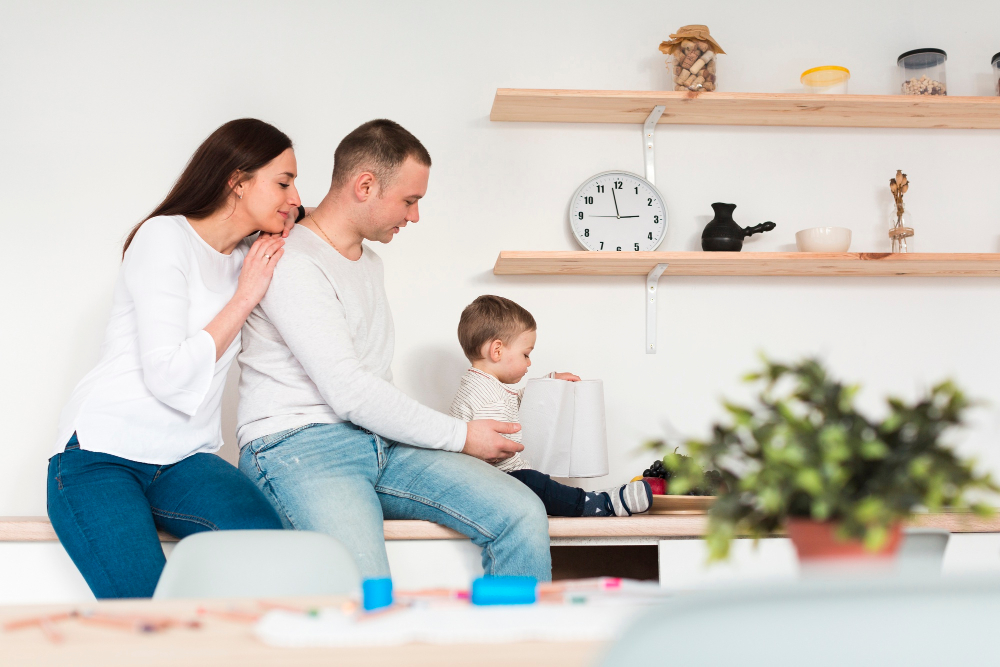kid

The 10 Timeless Principles of Good Parenting
Parenting can be both a rewarding and challenging journey. While there’s no one-size-fits-all approach to raising children, certain timeless principles of good parenting can serve as a reliable compass to navigate this incredible adventure. Whether you’re a new parent or have years of experience, these timeless principles of good parenting can help you build strong, loving relationships with your children and raise them to become happy, responsible, and well-adjusted adults.
Unconditional Love
At the heart of good parenting lies unconditional love. Your children should always feel loved and accepted, regardless of their actions, achievements, or mistakes. Love provides them with a secure foundation upon which they can build their self-esteem and confidence.
Effective Communication
Effective communication is key to understanding your child’s thoughts, feelings, and needs and is one of the foremost principles of good parenting. Listen actively, ask open-ended questions, and show empathy. Encourage your child to express themselves, and be attentive to their non-verbal cues. Good communication fosters trust and helps resolve conflicts.
Consistency and Boundaries
Children thrive in a structured environment with clear rules and boundaries. Be consistent in your discipline and expectations, and explain the reasons behind your rules. Consistency helps children feel secure and understand the consequences of their actions.
Positive Reinforcement
Praise and positive reinforcement go a long way in motivating children to make good choices and are one of the foremost principles of good parenting. Acknowledge their efforts and achievements, no matter how small. This encourages them to develop a positive self-image and reinforces desired behaviors.
Lead by Example
Children often model their behavior after their parents. Be a role model by demonstrating the values and behaviors you want to instill in your child. Show respect, kindness, and responsibility in your actions, and your child is likely to follow suit.
Patience
Parenting can test your patience, but it’s essential to remain calm and composed when it comes to principles of good parenting. Understand that children will make mistakes and have their own pace of development. Patience allows you to guide them gently through challenges and setbacks.
Quality Time
In today’s busy world, spending quality time with your children is crucial. Set aside dedicated moments for bonding, whether it’s reading a bedtime story, playing games, or having family meals together. These moments create lasting memories and strengthen your connection.
Encourage Independence
As your child grows, encourage their independence and decision-making skills, this is one of the foremost principles of good parenting. Allow them to take on age-appropriate responsibilities and learn from their experiences. Empowering them fosters self-confidence and resilience.
Flexibility
While consistency is important, it’s also vital to adapt to your child’s changing needs and stages of development. Flexibility allows you to adjust your parenting approach to meet their evolving requirements.
Be Present
In the age of smartphones and constant distractions, being present with your child is more important than ever. Put away screens and focus on the here and now when you’re with your child. Show them that they have your full attention and support.
Good parenting is a lifelong journey filled with love, challenges, and growth. By following these timeless principles of good parenting, you can build strong, loving relationships with your children. Remember that no one is a perfect parent, but your dedication to these principles will guide you on the path to raising happy, responsible, and well-adjusted adults.

5 Best Ways to Childproof a Bedroom
As parents, one of our foremost preferences is ensuring the safety and well-being of our kids. When it comes to childproofing our homes, the bedroom is a crucial area to concentrate on. Kids spend a considerable amount of time in their bedrooms, and it’s vital to create a safe atmosphere for them to play and nap. In this blog, we’ll explore the five best ways to childproof a bedroom.
Secure Furniture and Electronics
Children are curious explorers, and they often see furniture and electronics as fascinating climbing challenges. To prevent accidents, secure heavy furniture like dressers, bookshelves, and TVs to the wall using safety straps or brackets. One of the best ways to childproof a bedroom is to ensure electrical cords are out of reach and consider using outlet covers to prevent little fingers from poking into sockets.
Choose Child-Safe Bedding
Opt for bedding materials that are free from harmful chemicals and toxins. Look for mattresses and bedding labeled as “hypoallergenic” or “organic.” Ensure that crib mattresses fit snugly in the crib and that there are no gaps that could trap a child. Avoid using pillows, blankets, or stuffed animals in a crib until the child is old enough to sleep with them safely.
Use Safety Gates
When finding ways to childproof a bedroom, safety gates are a parent’s best friend. Placing gates at the bedroom door or the top of stairs can prevent your little one from wandering into potentially dangerous areas. Make sure the gates are sturdy and securely installed to prevent them from being pushed down.
Keep Small Objects Out of Reach
Children love to put things in their mouths, and small objects can be choking hazards. Regularly check the bedroom floor for tiny items like coins, buttons, or small toys when finding ways to childproof a bedroom. Invest in storage solutions like bins, shelves, and toy chests to keep small items out of your child’s reach. This will also help keep the room tidy and organized.
Install Window Safety Measures
Windows can pose a significant safety risk for children. To prevent falls, install window guards or window stops that limit how far the window can be opened. Ensure that blinds or curtains have no accessible cords that a child could become entangled in. Cordless blinds or curtains with a wand control are safer options.
These are the best ways to childproof a bedroom. Childproofing a bedroom is a crucial step in creating a safe and nurturing environment for your little one. By securing furniture, choosing child-safe bedding, using safety gates, keeping small objects out of reach, and installing window safety measures, you can significantly reduce the risk of accidents and provide your child with a safe space to grow and play. Remember, childproofing is an ongoing process, so regularly assess your child’s environment as they grow and develop new skills. Your child’s safety and well-being are worth the effort.

10 Red Flags In Teenage Behavior
Navigating the stormy waters of juvenility can be hard for teenagers and their parents. It’s a time of transition, self-discovery, and propelling boundaries. Nevertheless, it’s likewise a time when some teenagers may exhibit concerning behaviors. As a parent, it’s essential to be mindful of these red flags in teenage behavior to furnish vital support and guidance. So here are ten warning signs or red flags in teenage behavior to watch out for:
Impulsive Isolation
If your once-social teenager unexpectedly withdraws from pals and family, spending most of their time isolated in their space, it could be one of the red flags in teenage behavior of emotional distress.
Drastic Mood Swings
While mood swings are expected in teenagers due to hormonal transformations, intense and prolonged changes in mood can display deeper emotional or psychological problems.
Intense Shifts in Academic Performance
An impulsive drop in grades, lack of interest in school, or missing classes can signal educational troubles or underlying issues like stress or depression, which are the red flags in teenage behavior.
Substance Abuse
Experimentation with drugs or liquor is not strange among teenagers, but when it becomes regular and challenging, it’s time for concern and can be deemed as one of the severe red flags in teenage behavior.
Assertive Behavior
Regular outbursts of rage, physical violence, or intense defiance toward authority figures could indicate underlying anger or emotional problems.
Excessive Screen Time
While technology is an essential part of everyday life, extreme screen time, especially late at night, can negatively affect a teen’s mental health and sleep patterns.
Eating Disorders
Severe changes in eating habits, obsession with body image, or substantial weight loss or gain may be signs of an eating disorder like anorexia or bulimia.
Self-harm or Suicidal Thinking
Any symptoms of self-inflicted injuries, like mowing or burning, or expressing thoughts of self-harm or suicide, should be taken very seriously and need prompt proficient help.
Confidential Behavior
While teenagers inherently aim for privacy, outrageous secretiveness, lying, or hiding activities could be signs of inappropriate behavior.
Peer Pressure and Risky Behavior
If your teen caves to peer pressure and engages in scary behaviors like careless driving, substance abuse, or unprotected sex, it’s a sign of vulnerability.
What to Do:
Identifying these red flags in teenage behavior is just the foremost step. Here’s what you can do:
Open-minded Communication: Create a secure space for your teenager to talk openly about their emotions and experiences.
Seek Professional Help: If you witness any symptoms of self-harm, suicidal thoughts, or severe emotional distress, consult a mental health professional immediately.
Set Boundaries: Establish proper rules and boundaries while respecting their growing independence.
Stay Informed: Keep up with their social circles and be mindful of their companions and activities.
Lead by Example: Standard healthy behaviors and coping mechanisms for managing stress and emotions.
Parenting a teenager is not a straightforward task, but being alert about red flags in teenage behavior can help you provide crucial support and direction during this critical stage of their development. Remember that seeking proficient help when needed is a crucial step in ensuring your teenager’s well-being and forthcoming success.
